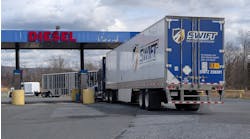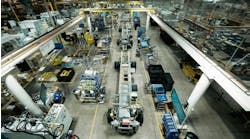Q&A: How EverCharge’s simple focus keeps EV infrastructure growing
For most fleet managers, electrification is a complicated, expensive mystery. For California-based EverCharge, though, simplifying electrification is ingrained in the company’s mission.
Since 2013, the company has primarily focused on building charging infrastructure for multifamily housing, such as apartments, and traditional fleets. According to Jeff Kinsey, EverCharge’s VP of engineering, the two overlap in several ways, including existing infrastructure and networking requirements.
Fleets typically already have existing infrastructure, such as buildings and depots. While adapting a garage for home charging can be simple, electrifying a depot has more challenges.
One example Kinsey gives: Loading docks tend to have almost no space between parked vehicles. Embedding a charger into a facility like that so a vehicle can park, charge, and still be loaded for last-mile deliveries is challenging, to say the least.
See also: What it takes to build charging infrastructure, according to a utility provider
Obviously, there’s no one-size-fits-all solution, or, as Kinsey noted, “the world would have electrified already.” Many providers fall into the trap of trying to sell EV charging as “the modern gas station,” he added.
But that, Kinsey says, is a mistake. EV charging isn’t just changing the fuel type but how fueling works altogether—as there’s a lot of efficiency in charging vehicles while loading or unloading.
“With EVs, the driver can park it, plug it in, and then they walk away and can be doing something else,” Kinsey said. “Their routes could be longer, they could be working on the next day’s routes, loading a truck, they could be doing all sorts of other stuff. But you don't get those benefits without essentially integrating it deep inside of your operations.”
This idea is the same for multi-unit dwellings. When considering charger installation, there’s existing infrastructure and the need for data and networking infrastructure on-site, something many owners don’t think about.
The specifics differ a bit: Apartment complexes focus on authentication, billing, and reimbursements, while fleets concentrate on utilization analyses such as final time, free time, and charging amount.
That need for on-site networking is where EverCharge’s mesh network gets its chance to shine. The network contains a cellular uplink for chargers, meaning it doesn’t need to be integrated with existing IT systems. The “smart chargers” can authenticate, report, and more.
“Essentially everything you expect out of a very smart device, but it doesn't require you to add any infrastructure to your site,” Kinsey said.
Kinsey shared more about EverCharge’s technology solutions, multi-unit dwelling vs fleet considerations, and how the industry might carve out a unique skill niche in this FleetOwner interview.
See also: Depot operations show electric truck potential growing
The nuances of fleet EV charging
The following Q&A between EverCharge’s Jeff Kinsey and FleetOwner has been edited for clarity.
FO: What is some of EverCharge’s technology that sets it apart?
Kinsey: EverCharge built Smart Power technology quite a few years ago, but now it's become far more relevant in fleets. It allows us to dramatically increase the number of vehicles that can be charged on a limited amount of energy.
Everyone's been freaking out that there isn’t enough power, and that’s somewhat true. Still, it's been a lot about the distribution of power, and the dirty little secret about EVs is that frequently they don’t get empty; they usually get charged before that. But dedicating power to a charger is, frankly, overbuilding. It’s done charging in an hour or two, but the rest of the time it’s parked there, that power is wasted.
When Class 6 EVs first came out, they had large batteries. They're getting smaller batteries because many vehicles don't drive all that far. But if there's a trend to have smaller and smaller batteries in them, then there needs to be a corresponding trend for an energy management system that tailors the amount of charging to the vehicles and the amount of power that they actually need to use.
FO: What has EverCharge learned about electrification with its focus on both fleets and multifamily housing?
Kinsey: The couple of things that fleets and MUDs (multi-unit dwellings) have in common is that the dwell-time principle applies to both. If you’re not using load balancing across your charge points, you’re wasting money.
It is surprising how few miles people drive daily; the average California driver drives 14,000 miles yearly. If you break that down, the average driver needs about 10 kWh daily. That person returns to their condo or apartment building at the end of the day and charges their car on a dedicated 48 AMP charger for one hour. But they're parked there for 12, so 90% of the time, it uses a resource it doesn't actually need.
Fleets are the exact same. Both must consider power to an EVSE (electric vehicle supply equipment) and then consider how long an asset will sit there. That's the total amount of energy opportunity that a charger can provide, and if that's larger than your average car needs, you've wasted a whole bunch of infrastructure.
FO: Do you anticipate more EV-related niches for charging in the near and distant future?
Kinsey: I think it's highly dependent on the growth of the charging industry. Fleets will electrify because it affects their bottom line; it is a cheaper, more predictable way to run their fleet. When those numbers start getting larger and larger, fleets look for people who have experience.
It’s not unlearnable, obviously, because the industry is growing. But if you hire someone who's never done it before to install your EV chargers, they might mess up, and it might take you more time to figure that out. If you're the person running the electric fleet, that time is money.
FO: How does EverCharge’s business model set it up for success for the rest of this decade?
Kinsey: A difficult thing about rolling out a high-tech product is that you can't make it complicated. We often think we should build mobile apps and dashboards, but drivers might not have access to a cellphone, or managers don’t want to give them too much tech because turnover is high.
So, our job is to take something complex and make it simple. You could build a mobile app with notifications or send a text. Everyone's phone has texts. The same applies to EV technology; everyone knows how to use a gas nozzle, so charging must be just as simple with no extra stuff on top of that. It also makes it easier to deploy, something EV turnkeys typically aren’t. It’s a facet we focus on.
An example of how EverCharge does this is when a vehicle needs to be moved. It’s a simple LED light on top of the pedestal. If it’s blinking, move the car. If it’s not, don’t look at it. It makes training new hires very simple, which reduces mistakes and saves training time.




